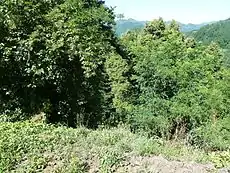Dasysyrphus pinastri
Dasysyrphus pinastri is a European species of hoverfly.[1][2][3]
| Dasysyrphus pinastri | |
|---|---|
| Scientific classification | |
| Kingdom: | |
| Phylum: | |
| Class: | |
| Order: | |
| Family: | |
| Genus: | |
| Species: | D. pinastri |
| Binomial name | |
| Dasysyrphus pinastri De Geer, 1776 | |
| Synonyms | |
| |
Description
For terms see Morphology of Diptera.
Wing length 6.5-8.5 mm.
Sternite 2 yellow with blackish crossband. Female frons with large patches of dust. Tergites 3 and 4 with equally-sized yellow patterns Tergite 2: pale pattern always present, as broad as or broader than pattern on tergites 3 and 4. Only vague or no grey stripes on thorax. Male genitalia are figured by Doczkal (1996).[4] The larva is figured by Nielsen (1954).[5][6][7][8][9]
Distribution
Palaearctic. Greenland, Iceland and Fennoscandia southwards to the Pyrenees. Ireland eastwards through northern and central Europe (and mountains of northern Italy and Yugoslavia) into Turkey and European Russia then through the Russian Far East and Siberia.[10][11]

Biology
Habitat: Abies, Picea and Pinus conifer forest and conifer plantation, montane Betula woods.[12] Arboreal, but descends to visit flowers of Caltha, Crataegus, Crepis paludosa, Euphorbia, Fragaria, Frangula alnus, Galium, Heracleum, Hieracium, Lonicera xylosteum, Prunus spinosa, Ranunculus, Rosa rugosa, Salix repens, Sorbus aucuparia and Stellaria.[13] The flight period is April to June and July (later at higher altitudes or more northerly latitudes). The larva feeds on aphids.
References
- Stubbs, Alan E.; Falk, Steven J (1983). British Hoverflies: An Illustrated Identification Guide (2nd ed.). London: British Entomological and Natural History Society. pp. 253, xvpp. ISBN 1-899935-03-7.
- Ball, S.G.; Morris, R.K.A. (2000). Provisional atlas of British hoverflies (Diptera, Syrphidae). Monks Wood, UK: Biological Record Centre. pp. 167 pages. ISBN 1-870393-54-6.
- Van Veen, M.P. (2004). Hoverflies of Northwest Europe, Identification Keys to the Syrphidae (Hardback). Utrecht: KNNV Publishing. p. 254. ISBN 90-5011-199-8.
- Doczkal, D. (1996a) Schwebfliegen aus Deutschland: Erstnachweise und wenig bekannte Arten (Diptera, Syrphidae). Volucella, 2: 36-62.
- Nielsen, P., Ringdahl, O. & Tuxen, S.L. (1954) Family Syrphidae. Zoology of Iceland, 3(48a): 60-74.
- Van Veen, M. (2004) Hoverflies of Northwest Europe: identification keys to the Syrphidae. 256pp. KNNV Publishing, Utrecht.addendum
- Van der Goot,V.S. (1981) De zweefvliegen van Noordwest - Europa en Europees Rusland, in het bijzonder van de Benelux. KNNV, Uitgave no.32: 275pp. Amsterdam.
- Bei-Bienko, G.Y. & Steyskal, G.C. (1988) Keys to the Insects of the European Part of the USSR, Volume V: Diptera and Siphonaptera, Part I. Amerind Publishing Co., New Delhi. ISBN 81-205-0080-6.
- Coe, R.L. (1953) Diptera: Syrphidae. Handbks.ident.Br.insects, 10(1): 1-98. R.ent.Soc.London. pdf
- Fauna Europaea
- Peck, L.V. (1988) Syrphidae. In: Soos, A. & Papp, L. (eds.) Catalogue of Palaearctic Diptera, 8: 11-230. Akad.Kiado, Budapest.
- Speight, M.C.D. (2011). "Species accounts of European Syrphidae (Diptera)" (PDF). Syrph the Net, the database of European Syrphidae. 65: 285pp.
- de Buck, N. (1990) Bloembezoek en bestuivingsecologie van Zweefvliegen (Diptera, Syrphidae) in het bijzonder voor België. Doc.Trav. IRSNB, no.60, 1-167.